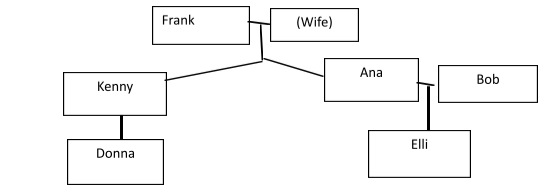What are family-based questions?
Family-based questions are mostly plotted based on blood relations and are the most asked questions in the logical reasoning portion of any exam. It requires a confident knowledge of different blood relations. While trying to understand them, you need to be extremely careful as they are quite confusing.
First, we need to understand blood relations. Then only we will be able to solve the questions. Below, I have drawn a blood relations chart; let’s have a look at it.
Blood Relation Chart

As you can see in the given chart, your father’s or mother’s parents are your Grandparents, so their grandparents should be your great grandparents. Similarly, you are your grandparent’s granddaughter/grandson and your brother, their grandson. Furthermore, your parents, whether mother’s or father’s, brother is your uncle and their sister, your aunt. You are your uncle’s/aunt’s niece/nephew, and your brother is their nephew. Also, your uncle’s or aunt’s kids are your cousins. Now, when you get married, your husband’s/wife’s parents will be your father-in-law and mother-in-law, and his/her brother or sister will be your brother-in-law or sister-in-law, respectively.
Let us try to solve some examples; it will help you understand better.
We will go from easier questions to complex questions.
Q.1. Suppose that ‘A’ is the uncle of ‘B’, and ‘C’ is the paternal grandfather of ‘B’. What is the relation between ‘A’ and ‘C’?
Solution: Refer to the blood relations chart and try to solve this family-based problem.
Given: ‘A’ – uncle of ‘B’ and ‘C’ – grandfather of ‘B.’
Therefore, B’s father is A’s brother
According to the given chart, we call the father’s parents a paternal grandfather.
And hence, ‘C’ is the father of ‘A’.
Q.2. Suppose that Ravi and Simi are brother and sister by blood, and Kiran is Ravi’s mother. What is the relation between Simi and Kiran?
Solution-
Given: Ravi and Simran are brother and sister by blood.
Kiran is Ravi’s mother.
Based on the first given sentence, Ravi and Kiran should have the same parent. So, if Kiran is Ravi’s mother, she should also be Mimi’s mother.
Hence, Simi is Kiran’s daughter.
Q.3. Suppose that there are four people in a room, P, Q, R, and S. P is R’s son, and R is S’s husband. Q is P’s wife. What is the relation between S and Q?
Solution- Based on the blood relation chart, try solving the given question.
Given: P – son of R Q- wife of P

And as Q is P’s wife, she is the daughter-in-law of S.
Q.4. Suppose that Anil is the father of Deep. Anil has 2 children. Deep is the brother of Suzie. Suzie is the daughter of Sumi. Neha is the granddaughter of Anil. Dev is the father of Neha. What is the relation between Dev and Sumi?
Solution-
Given: Anil – father of Deep Deep- Suzie’s brother
Sumi- Suzie’s daughter Neha- granddaughter of Anil
Dev- Neha’s father
According to the blood relations chart, let’s draw the family tree for this problem.

Hence, as Neha is Anil’s and Sumi’s granddaughter, and as they have only two kids, So, Dev must be Sumi’s Son-in-law.
Q.5. Keith is the son of Tom. Sam is Tom’s sister and has a son, Max and a daughter, Sue. Pam is their maternal aunt of Max. What is the relationship between Keith and Max?
Solution: Refer to the blood relations chart and try to solve this family-based problem.
Given: Keth- Son of Tom Tom- Sam’s brother
Sam- Mother of Max and Sue Pam- Max’s aunt
Therefore, as Tom and Sam are siblings hence, their children will be cousins. So, Keth and Max are cousins brothers.
Now let’s try to solve a difficult question-
Q.6. In a family, there are 6 members, Ana, Bob, Kenny, Donna, Elli, and Frank. Anna and Bob are husband and wife. Donna is the only daughter of Kenny, who is their brother. Elli is the sister of Donna. Bob is the son-in-law of Frank, whose wife died. How is Elli related to Kenny?

Therefore, Kenny has only one daughter, and Elli is Donna’s sister. So, Elli must be Kenny’s sister Ana’s daughter.
Hence, Elli is Kenny’s niece.
FAQs (Frequently Asked Questions)
Q1. How can we easily solve family-based questions?
Ans. You should always refer to the blood relation chart and try to draw it before you start with these types of questions.
You can also put yourself in somebody’s place and relate it to your own family tree.
Conclusion
Family-based questions are pretty frequently asked in any national or international exams in the aptitude section and are very mark fetching. They are not only interesting and fun but are also helpful in improving your intellectual abilities. So, learning how to solve them will be very helpful from all perspectives.
 Profile
Profile Settings
Settings Refer your friends
Refer your friends Sign out
Sign out






